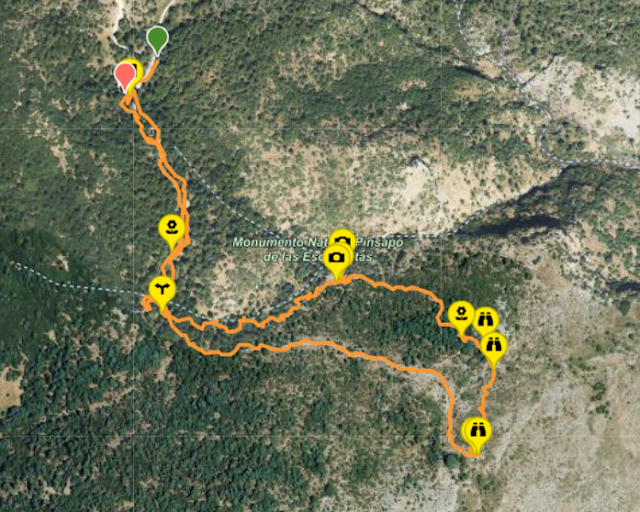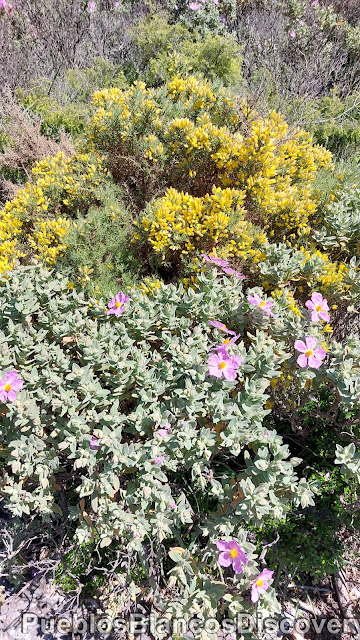The Hike to the Natural Monument of
"Pinsapo de las Escaleretas"
Prologue:
This part of the Sierra de las Nieves Nature park was unique in its own way, not only are you able to see the oldest Spanish fir tree (Pinsapo), believed to be more then 350 years old and declared as a National Monument, you are also facing the highest mountain peak, Torrecilla (1919m) in the Province of Málaga, close up, which is quite an impressive site.
The hike itself was a very pleasant, approx. 3 km, circular walk, with stunning panoramic views along the way, and to be surrounded by a mature natural deciduous forest.
I would like to mention, as you enter into the Nature Park and onto a gravel road, that you might find the road very curvy and somehow narrow, but during the week their is hardly any traffic at all.
Map of the Hike
 |
| Click on link: Wikiloc Monumento Pinsapo de las Escaleretas, Sierra de las Nieves |
Map of the Sierra de las Nieves Nature Park
Sierra de las Nieves National Park is located in the western part of the Málaga Province, bounded to the south by the western Costa del Sol, to the east by the Guadalhorce Valley, to the west by the town of Ronda and the Genal valley, and to the north the area of Guadalteba.
The park covers an area of 20.163 hectares. The most striking features of the Sierra de las Nieves are the brilliant white and quite bare looking limestone mountains. The highest peak is the mount Torrecilla (1919m).
Sierra de las Nieves has been long known for its biodiversity and uniqueness. The emblematic Spanish fir El Pinsapar (Abies pinsapo) is a botanical relic from the ice age, and a large forest can still be found in this area, since the discovery in 1837 by the Swiss botanist Edmond Boissier, who raised the awareness and interest of protection for this mountainous region.
Finally in July 2021 the Sierra de las Nieves was declared a National Park (Parque Nacional de las Sierra de las Nieves)
Information translated from the board.
The name of the Escaleretes comes from the arrangement of the limestone slabs in the area like steps. Step by step it will take us to discover botanical jewels such as Spanish firs or mountain gall oaks.
On our walk we can observe the regeneration of young firs, as well as the presence of an outstanding undergrowth made up of rockrose, some junipers, marjoram, Jerusalem Sage peony, ferns and, above all, a large number of lichens and appreciable beauty of the place.
We continue the path until we reach a fork and take the path on our left. We arrive, through a circular route, to the Pinsapo de las Escaleretas Natural Monument. This prodigious tree, more than 350 years old, is the largest fir in the entire Natural Park, since its height exceeds 26 meters and its trunk has a perimeter of 9 meters at its base. According to legend, this tree grew on the grave of a woman, known for helping walkers and people of the mountains, whom she cured using natural remedies.
We return to the path and continue in an easterly direction. Suddenly, the bushes end abruptly and we arrive at a kind of rocky platform from where we can see a magnificent panoramic view of the Rio Verde valley, the south face of the Torrecilla peak and Sierra Real. The destructive fire of 1991 reached this place. On the way down we must try not to lose the old path that zigzags throughout the headwaters of the Verde River, La Nava and Ronda.
Back on the lane, the return journey must be made on the same route, which is the only public use road in the area.
Recommendations: Mountain boots and warm clothing depending on the weather. In case of fog, blizzard or bad weather, do not continue the path. Remember that you are in high mountain terrain.
The Spanish fir, El Pinsapar (Abies pinsapo) is a species of fir found in southern Spain and northern Morocco. Related to other species of Mediterranean firs, it is considered the Andalusian National Tree, and is native to the Andalusian mountains. It appears in the Sierra de las Nieves by Ronda, and Sierra Bermeja in the Province of Málaga and Sierra de Grazalema in the province of Cádiz at altitudes of 900 - 1.800 m.
The Pinsapo can reach a height of 20-30 meters. They have to withstand very harsh conditions, very cold winters as this area is very often covered in snow, and very hot dry summers. They are able to pick up the moisture from the air with their short dense needles.
Directions:
- Coming onto the A7 from Marbella, take the exit at San Pedro de Alcantara onto the A-397 towards Ronda.
- After approx. 35 km/40 minutes take the exit on the right towards the Area Recreativa Quejigales, Sierra de las Nieves National Park.
- You follow a well maintained gravel road (Camino de Tolox) for approx. 15 min. until you face a road barrier ahead, there you turn right and drive for further 10 min. until you come to a large clearing with a Spanish fir tree in the middle.
- It is here were you can park your car and the walkway will begin.
- The total journey from San Pedro de Alcantara takes about 1 hour/44,5 km drive.
- It is a very scenic drive, but keep in mind that you are in a mountainous region.
- Note: In the winter months the road Camino de Tolox might be closed due to snowy and Icey conditions.
Soon after we left the main road A-397 to Ronda,
we were greeted by a flock of sheep grazing in a meadow.
Carefully we drove past the resting sheep, some of them seemed to be heavily pregnant.
At a road junction we turned right and followed the road for a further 2,4 km.
We drive slowly along the hillside to enjoy the panoramic views.
What an idyllic setting, a lonely farm within the Nature Park.
We have reached a clearing with a large Pinsapo in its centre.
The forest road carries on from here towards the village of Tolox.
We parked our car here and had a look at the various information boards before we set of.
Being surrounded by a mature natural deciduous forest gives us great pleasure.
Even so, throughout the whole walk we noticed many trees which seem to suffer from the drought in the year 2024.
Some trees are covered with moss and lichen.
You find Rock roses, Jara blanca, throughout the Iberian Peninsula in dry rocky terrain.
They come in various sizes from pinks to lilac and white.
 |
| Rock roses, Jara blanca, (Cistus albidus) |
At 325 meters we have reached the main attraction on this route.
This tree is barely alive!
It is covered with lichen and moss.
At this section you find the layers of rock which gives this area the name "Escaletas".
The name of the Escaleretes comes from the arrangement of the limestone slabs in the area like steps. Step by step it will take us to discover botanical jewels such as Spanish firs or mountain gall oaks.
We follow the arrow.
At a higher altitude the forest thins out.
A few slabs of rocks gives us a good viewing point.
Ahead of us a man made viewpoint, (Mirador).
And there is the tree which gives this viewpoint the name.
This prodigious tree, more than 350 years old, is the largest fir in the entire Natural Park, since its height exceeds 26 meters and its trunk has a perimeter of 9 meters at its base. According to legend, this tree grew on the grave of a woman, known for helping walkers and people of the mountains, whom she cured using natural remedies.
It looks very impressive.
Quite majestic and grand!
We hope he has many more years left.
A last look at the old tree and we carry on our way.
Across the valley, the Torrecilla massif at 1919 meters at the highest point.
Throughout our walk we notice trees which are suffering badly from the drought.
Many unfortunately have already died.
We follow the arrow through the rocky maize.
To see wild Peonies growing in this forest was certainly a highlight for us.
The Wild Peony is a 0,5-1,5 meter herbaceous perennial plant with large red flowers, which bloom from late spring to early summer (April to June). They prefer acid and neutral soils, full light in semi shade places, and also tolerates dry periods.
Wild Peonies can be found throughout the Iberian peninsula and in many Mediterranean countries. The root of the Peony contains medicinal properties and its usage dates back to the 4th century BC. Traditionally used to combat seizures, headaches, dizziness etc....
Across the valley we notice a road which is carved into the side of the mountain.
The road leads to the village of Tolox.
A view along the valley and towards the Mediterranean coast, which is on the horizon.
Below us the river valley of the Rio Verde and
in the distance the mountain rage of the Sierra Blanca.
The track winds upwards and towards another viewpoint.
We find ourselves on a rocky plateau.
Mirador del puntal de la Mesa 1197 meters above sea level.
Stunning panoramic views!
A view along the ridge which leads up towards the highest peak in the Málaga Province,
Torrecilla (1919m).
Somewhere below us is the source of the Rio verde.
It is its water which a great part of the Costa del Sol depends on for drinking water.
At this altitude you find low bushes of
Ginesta (Broom), Rock roses, Rosemary, Lavender bushes and many more.....
It is hardly to imagine that once stood a tree here.
A view across the forest. Some more trees seeming to suffer badly from the drought.
Even though we witnessed many trees which were dying,
there is still hope, when seeing a young Pinsapo.
A Holm oak tree in bloom.
We are back in the forested area.
Having reach the road junction where we left our car,
our hearts are filled with pleasure to have found this unique trail.
We drove back the same road we came on and
enjoyed the panoramic views all the way.
Click on link: Wikiloc: Monumento Pinsapo de las Escaleretas, Sierra de las Nieves
How to get to Monumento Pinsapo Escalereta
Related links: Quejigales, Sierra de las Nieves National Park
Sierra de las Nieves (Snow Mountains)









.jpg)
.jpg)
.jpg)


.jpg)
.jpg)
.jpg)
.jpg)

.jpg)
.jpg)






























































No comments:
Post a Comment